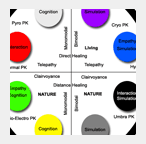Telepathy
Parapsychology Articles, Papers and Books
Home > Articles > Psychical Phenomena > Extrasensory Perception > Telepathy
![]()
|
| NEWSLETTERS |
| Get the best from QPsychics.com in your inbox! |
|
| PARAPSYCHOLOGY ORGANIZATIONS |
"With confidence in the importance of utilizing the investigative mode of the established sciences in order to inquire into the authenticity and to potentially explain the nature of psychical phenomena."  |
 |
 |
 |
 |
Telepathic Simulation
Telepathy is the psychical influence of thought via experient influence over the biological basis of consciousness and the mental process by which we perceive, act, learn and remember; Including mental forms and processes such as the nervous system in which processes and transmits information by electrochemical signaling. Ostensible telepathic content-simulation or “telepathic simulation” has been defined as “a case in which an individual’s mental state appears to produce a similar mental state in someone else.” In other words, the telepathist’s mental state produces a similar mental state in the subject. Via this type of telepathy, the subject and telepathist do not “know” the mental state of the other participant, nor is the mental state “impressed.” In the case of this type of telepathy, the telepathist does not “know” telepathically what the mental state of the subject is, but rather it appears that the mental states of the telepathist and subject instantaneously become qualitatively identical. The identicalness of the mental state is debatable, as there is no empirical evidence to support this at this time. However, reports in regards to this form of telepathy suggest exact, or nearly exact, mental states rather than more associative states (e.g. a star for a star, rather than a star for a pinwheel or daisy). This type of telepathy also appears to be more non-invasive as the subject is typically is unaware that, or does not “know” that, the mental state is “not their own,” as it appears to be less intrusive than impression. The skilled telepathist would however be able to identify that the simulated mental state originated from (him) if the telepathist knowingly shared the idea with a subject. In other words, the telepathist can share (his) own mental state with the subject, or the telepathist can evoke the sharing process of the subject’s mental state to replace (his) own mental state. In the end, I believe the most efficient way to view telepathic content-simulation is as though the mental states have be shared via the exact transmission of the state from one participant to the other. The most common way in which this type of telepathy is utilized is to provide comfort and or motivation. In regards to comfort, if the telepathist and subject find themselves in a situation in which only the telepathist feels comfortable or safe, the telepathist can share (his) own behavioral state, or anxiety-neutral mental condition, with the subject, whereby non-invasively sharing (his) sense of security and comfort with the subject. A similar instance of this involves the sharing of the telepathist’s belief that an action is a “good idea.” This sense of security is shared with the subject leading the subject to bypass their natural inclinations.
(Adapted from the book “Telepathy: A Quantum Approach” by Theresa M. Kelly, MsD.)
|
|||
Related Articles |
|||

